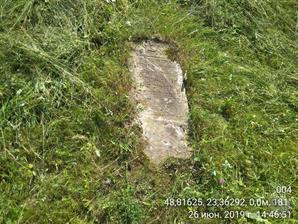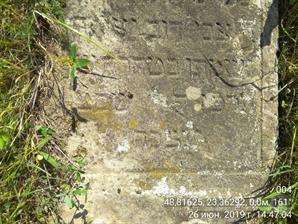Lavochne
Stryi district, Lviv region
 |
 |
 |
| Destroyed Jewish cemetery in Lavochne, 2019 | ||
 |
||
| Austrian soldiers in front of an armored train in Lavochne, 1915 |
Sources:
- Pinkas Hakehillot Polin: Encyclopedia of Jewish Communities, Poland, Volume II, page 527-528, published by Yad Vashem, Jerusalem. Translated by Jerrold Landau, JewishGen, Inc.
Photo:
- Jewish Cemeteries Initiative. Lavochne Jewish Cemetery
- Pinkas Hakehillot Polin: Encyclopedia of Jewish Communities, Poland, Volume II, page 527-528, published by Yad Vashem, Jerusalem. Translated by Jerrold Landau, JewishGen, Inc.
Photo:
- Jewish Cemeteries Initiative. Lavochne Jewish Cemetery
In 1921, approximately 140 Jews lived in Lawoczne (ukr. Lavochne, Лавочне). After the outbreak of the Second World War, the town of Lawoczne was under Soviet rule from September 1939 until June 1941.
At the end of June, after the retreat of the Soviets from Lawoczne, the Ukrainians perpetrated pogroms against the Jews throughout the region and killed many in the villages around Lawoczne (among others: In Slawsko 6 Jews, in Wolosianka – 33, in Rozanka – more than 60, and in Truchanow – 35 Jews).
The Ukrainian Priest in Lawoczne enticed the farmers to these bloody actions. There were no fatalities in Lawoczne itself. On July 5, 1941, the Hungarian army conquered Lawoczne, and put an end to the pogroms of the Ukrainians in the region. They even brought the guilty to a military court. Under Hungarian rule, the Jews of Lawoczne suffered only from confiscation of property for the army. Their situation deteriorated when the government was transferred to the Germans on August 15, 1941. Already during the first days of their government, two Jewish political refugees from Hungary were taken out to be shot.
The Jews of Lawoczne were frequently ordered to give over luxuries such as wine and liquor to the Germans. The Gestapo men in the region of Drohobycz would come to Lawoczne on occasion in order to collect the contribution. Jewish men between the ages of 14-60 were drafted to forced labor in building or repairing streets and bridges, and in cutting down trees in the forest. A group of youths were captured and sent to the work camp in Sinowodzko Wizna.
In July 1942, Gestapo men came to Lawoczne. With the assistance of the Ukrainian police, they captured 15 Jews from among the Hungarian refugees and took them out to be killed. The bodies were buried in a communal grave near the train station in Lawoczne.
In August 1942, there were still approximately 60 Jews in Lawoczne. On September 2, 1942 (according to another opinion, on August 2, 1942), the Gestapo men, the Ukrainian police, and the German border guard surrounded the Jewish homes and the area of the forest where the Jews worked, and deported them all to Skole (about 30 kilometers away). Many of the elderly and ill were murdered during the aktion.
A few Jews succeeded in escaping and fleeing across the border to Hungary.
In Skole, the deportees from Lawoczne were loaded upon transport trucks and sent to the Belzec death camp during the expulsion aktion of the Jews of that city (September 4, 1942).
At the end of June, after the retreat of the Soviets from Lawoczne, the Ukrainians perpetrated pogroms against the Jews throughout the region and killed many in the villages around Lawoczne (among others: In Slawsko 6 Jews, in Wolosianka – 33, in Rozanka – more than 60, and in Truchanow – 35 Jews).
The Ukrainian Priest in Lawoczne enticed the farmers to these bloody actions. There were no fatalities in Lawoczne itself. On July 5, 1941, the Hungarian army conquered Lawoczne, and put an end to the pogroms of the Ukrainians in the region. They even brought the guilty to a military court. Under Hungarian rule, the Jews of Lawoczne suffered only from confiscation of property for the army. Their situation deteriorated when the government was transferred to the Germans on August 15, 1941. Already during the first days of their government, two Jewish political refugees from Hungary were taken out to be shot.
The Jews of Lawoczne were frequently ordered to give over luxuries such as wine and liquor to the Germans. The Gestapo men in the region of Drohobycz would come to Lawoczne on occasion in order to collect the contribution. Jewish men between the ages of 14-60 were drafted to forced labor in building or repairing streets and bridges, and in cutting down trees in the forest. A group of youths were captured and sent to the work camp in Sinowodzko Wizna.
In July 1942, Gestapo men came to Lawoczne. With the assistance of the Ukrainian police, they captured 15 Jews from among the Hungarian refugees and took them out to be killed. The bodies were buried in a communal grave near the train station in Lawoczne.
In August 1942, there were still approximately 60 Jews in Lawoczne. On September 2, 1942 (according to another opinion, on August 2, 1942), the Gestapo men, the Ukrainian police, and the German border guard surrounded the Jewish homes and the area of the forest where the Jews worked, and deported them all to Skole (about 30 kilometers away). Many of the elderly and ill were murdered during the aktion.
A few Jews succeeded in escaping and fleeing across the border to Hungary.
In Skole, the deportees from Lawoczne were loaded upon transport trucks and sent to the Belzec death camp during the expulsion aktion of the Jews of that city (September 4, 1942).

- Home
- Shtetls
- Vinnytsia region
- Volyn region
- Dnipro region
- Donetsk region
- Zhytomyr region
- Zakarpattia region
- Zaporizhzhia region
- Ivano-Frankivsk region
- Kyiv region
- Kropyvnytskyi region
- Luhansk region
- Lviv region
- Mykolayiv region
- Odessa region
- Poltava region
- Rivne region
- Sumy region
- Ternopil region
- Kharkiv region
- Kherson region
- Khmelnytskyi region
- Chernihiv region
- Chernivtsi region
- Cherkasy region
- Crimea
- Synagogues
- Cemeteries
- Objects & guides
- Old photos
- History
- Contact
Jewish towns of Ukraine
Jewish towns of Ukraine
My shtetl
My shtetl
Donate